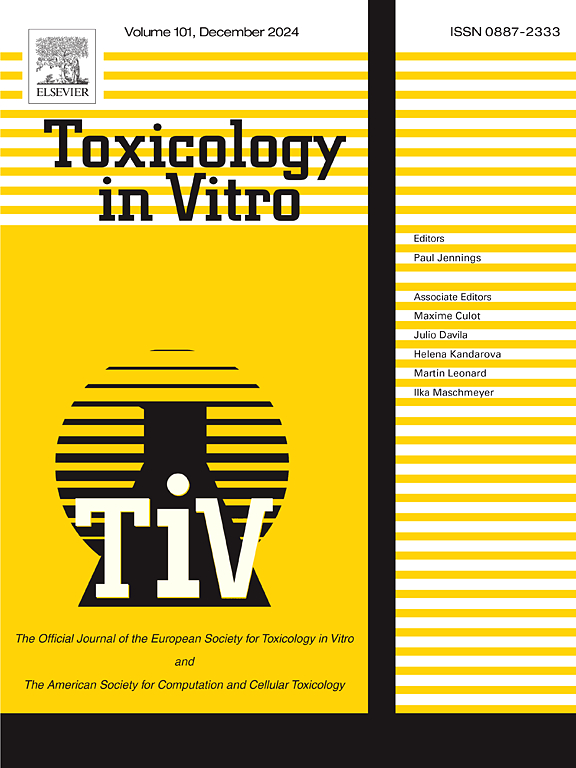利用二维人类肠道干细胞衍生模型预测腹泻风险的高通量测定。
IF 2.6
3区 医学
Q3 TOXICOLOGY
引用次数: 0
摘要
临床试验中的胃肠道毒性(GITs)通常导致剂量限制,从而降低药物疗效并延迟治疗优化。临床前动物模型不能准确地复制人体生理学,因此在进行人体研究之前,很少有办法早期发现胃肠道感染,比如腹泻。化疗药物,已知会引起临床腹泻,经常靶向有丝分裂细胞。因此,我们假设利用来自人类肠隐窝的增殖细胞群的模型可以高精度地预测临床腹泻的发生。在这里,我们描述了利用RepliGut®Planar(一种原代肠道干细胞衍生平台)开发的腹泻预测试验。为了评估该模型预测临床腹泻风险的能力,我们通过测量来自三名人类供体的细胞的细胞增殖(EdU掺入)、细胞丰度(细胞核量化)和屏障功能(TEER)来评估30种上市药物的毒性。生成每种药物的剂量反应曲线,并使用IC15与Cmax比值确定检测阳性的阈值。该模型准确地预测了腹泻的可能性,增殖的准确度为91 %,丰度的准确度为90 %,屏障形成的准确度为88 %。使用原代增殖细胞进行体外毒性筛选可以减少临床腹泻,并最终为患者带来更安全、更有效的治疗方法。本文章由计算机程序翻译,如有差异,请以英文原文为准。
High-throughput assay for predicting diarrhea risk using a 2D human intestinal stem cell-derived model
Gastrointestinal toxicities (GITs) in clinical trials often lead to dose-limitations that reduce drug efficacy and delay treatment optimization. Preclinical animal models do not accurately replicate human physiology, leaving few options for early detection of GITs, such as diarrhea, before human studies. Chemotherapeutic agents, known to cause clinical diarrhea, frequently target mitotic cells. Therefore, we hypothesized a model utilizing proliferative cell populations derived from human intestinal crypts would predict clinical diarrhea occurrence with high accuracy. Here, we describe the development of a diarrhea prediction assay utilizing RepliGut® Planar, a primary intestinal stem cell-derived platform. To evaluate the ability of this model to predict clinical diarrhea risk, we assessed toxicity of 30 marketed drugs by measuring cell proliferation (EdU incorporation), cell abundance (nuclei quantification), and barrier formation (TEER) in cells derived from three human donors. Dose response curves were generated for each drug, and the IC15 to Cmax ratio was used to identify a threshold for assay positivity. This model accurately predicted diarrhea potential, achieving an accuracy of 91 % for proliferation, 90 % for abundance, and 88 % for barrier formation. In vitro toxicity screening using primary proliferative cells may reduce clinical diarrhea and ultimately lead to safer and more effective treatments for patients.
求助全文
通过发布文献求助,成功后即可免费获取论文全文。
去求助
来源期刊

Toxicology in Vitro
医学-毒理学
CiteScore
6.50
自引率
3.10%
发文量
181
审稿时长
65 days
期刊介绍:
Toxicology in Vitro publishes original research papers and reviews on the application and use of in vitro systems for assessing or predicting the toxic effects of chemicals and elucidating their mechanisms of action. These in vitro techniques include utilizing cell or tissue cultures, isolated cells, tissue slices, subcellular fractions, transgenic cell cultures, and cells from transgenic organisms, as well as in silico modelling. The Journal will focus on investigations that involve the development and validation of new in vitro methods, e.g. for prediction of toxic effects based on traditional and in silico modelling; on the use of methods in high-throughput toxicology and pharmacology; elucidation of mechanisms of toxic action; the application of genomics, transcriptomics and proteomics in toxicology, as well as on comparative studies that characterise the relationship between in vitro and in vivo findings. The Journal strongly encourages the submission of manuscripts that focus on the development of in vitro methods, their practical applications and regulatory use (e.g. in the areas of food components cosmetics, pharmaceuticals, pesticides, and industrial chemicals). Toxicology in Vitro discourages papers that record reporting on toxicological effects from materials, such as plant extracts or herbal medicines, that have not been chemically characterized.
 求助内容:
求助内容: 应助结果提醒方式:
应助结果提醒方式:


